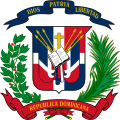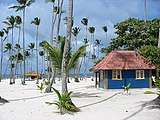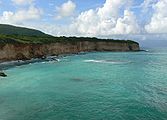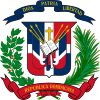Portal:Dominican Republic
Introduction
The Dominican Republic is a North American country located on the island of Hispaniola in the Greater Antilles of the Caribbean Sea in the North Atlantic Ocean. It shares a maritime border with Puerto Rico to the east and a land border with Haiti to the west, occupying the eastern five-eighths of Hispaniola which, along with Saint Martin, is one of only two islands in the Caribbean shared by two sovereign states. In the Antilles, the country is the second-largest nation by area after Cuba at 48,671 square kilometers (18,792 sq mi) and second-largest by population after Haiti with approximately 11.4 million people in 2024, of whom 3.6 million reside in the metropolitan area of Santo Domingo, the capital city. The Dominican Republic has the largest economy in the Caribbean and the seventh-largest in Latin America. Over the last 25 years, the Dominican Republic has had the fastest-growing economy in the Western Hemisphere – with an average real GDP growth rate of 5.3% between 1992 and 2018. GDP growth in 2014 and 2015 reached 7.3 and 7.0%, respectively, the highest in the Western Hemisphere. Recent growth has been driven by construction, manufacturing, tourism, and mining. The country is the site of the third largest (in terms of production) gold mine in the world, the Pueblo Viejo mine. The gold production of the country is 31 metric tonnes in 2015. The Dominican Republic is the most visited destination in the Caribbean. A geographically diverse nation, the Dominican Republic is home to both the Caribbean's tallest mountain peak, Pico Duarte, and the Caribbean's largest lake and lowest point, Lake Enriquillo. The island has an average temperature of 26 °C (78.8 °F) and great climatic and biological diversity. The country is also the site of the first cathedral, palace, monastery, and fortress built in the Americas, located in Santo Domingo's Colonial Zone, a World Heritage Site. (Full article...) Selected article -Samaná El Catey International Airport (IATA: AZS, ICAO: MDCY), also called Aeropuerto Internacional Presidente Juan Bosch (AISA), is an international airport that opened on 6 November 2006, serving the province of Samaná in the Dominican Republic. The airport is located near the village of El Catey, some 8 km (5.0 mi) west of Sánchez, at the base of the mountainous peninsula Cape Samana. Local travel times are given as 30 minutes drive to Las Terrenas, 40 minutes drive to the provincial capital, Santa Barbara de Samaná, and approximately one hour drive to Las Galeras. (Full article...) General images -The following are images from various Dominican Republic-related articles on Wikipedia.
Selected picture -Coral reef and school of yellow jack fish at Aquarium Reef, Catalina Island
Selected biography -Eduardo Michelle Núñez Méndez (born June 15, 1987) is a Dominican former professional baseball infielder. He played in Major League Baseball (MLB) for the New York Yankees, Minnesota Twins, San Francisco Giants, Boston Red Sox, and the New York Mets. He also played for the Fubon Guardians of the Chinese Professional Baseball League (CPBL) for one year. Núñez serves primarily as a utility infielder - playing third base, shortstop and second base - and has played in the outfield as well. The Yankees signed Núñez as an international free agent in 2004. He played minor league baseball in their organization from 2005 through 2010, until he made his MLB debut with the Yankees on August 19, 2010. Due to struggles and inconsistency, Núñez was designated for assignment by the Yankees at the start of the 2014 season. He was traded to the Twins, and enjoyed a breakout season in 2016, when he was named to appear in the MLB All-Star Game. He was traded to the Giants in 2016, and to the Red Sox in 2017. In July 2019, Núñez was designated for assignment and then released by the Red Sox. He signed a minor league contract with the New York Mets in 2020. (Full article...) Related portalsWikiProjects
Things to do
Associated WikimediaThe following Wikimedia Foundation sister projects provide more on this subject:
SourcesDiscover Wikipedia using portals | |||||||||||||||||||||||||



















































































